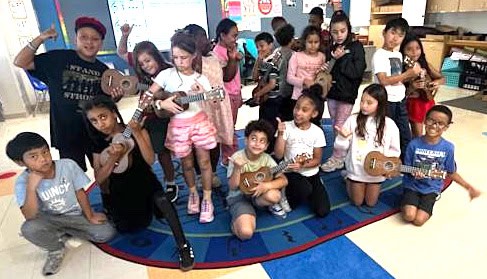Special to The Advocate
Malden Public Schools received a generous grant from the Mass Cultural Council to support two different art projects in the K-8 schools over the course of the school year.
The first part of the grant supported the purchase of 25 ukuleles for use by students at Linden STEAM Academy. Music teacher Emily Wolf used the ukuleles in her classroom, teaching Grade 3 and Grade 4 students how to play the instrument. Playing the ukulele also supports student’s learning to read music, recognize rhythms and feel comfortable performing.
The second part of the grant supported a mural project, inspired by the art of Malden’s own Frank Stella, completed by art students at Beebe School. The mural was completed by Grade 7 and Grade 8 students in Jess Howard’s art class in the spring of 2025. The grant money was used to purchase materials for the mural, such as paint, brushes and mural panels. The grant money was also used to purchase adaptive art materials, allowing students with disabilities to better participate in art classes.
“We are thankful for the funding provided by the Mass Cultural Council that allowed us to complete these projects,” said Gerard Tannetta, Director of Social Studies and Visual and Performing Arts. “We are looking forward to the ukuleles and adaptive art supplies being used by students for years to come.”
***
FUN FACT: Do you know how the ukulele first came into vogue in the United States?
Everyone associates ukuleles with Hawaiian music and rightly so, since that is where they became wildly popular in the late 1880s when three immigrants from Portugal arrived in Hawaii — and brought the four-stringed instruments with them. Three of the immigrants, Manuel Nunes, Augusto Dias and Jose do Espirito Santo, were woodworkers and cabinetmakers who began crafting ukuleles in Honolulu after their plantation work. The instrument was created from a hybrid of the machete and the Portuguese rajão and was adapted to be made with native koa wood. The instrument was called “ukulele,” which translates to “jumping flea” in Hawaiian, referring to the rapid movement of the players’ fingers.
It was embraced by the Hawaiian royal family, with King David Kalākaua being a major patron who incorporated it into court music and royal performances. This association with royalty and Hawaiian culture solidified its place as a national symbol, particularly at festive events like luaus. The Panama-Pacific International Exposition in San Francisco in 1915 featured a popular Hawaiian Pavilion, fueling a ukulele craze that spread across the country.



